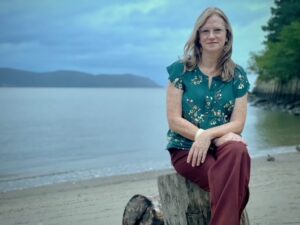 It all began with a dip in the Hudson.
It all began with a dip in the Hudson.
When Tracy Brown, who became the first woman president of the Riverkeeper advocacy organization on Nov. 1, was house hunting around Sleepy Hollow in 2003, she was invited to the Philipse Manor Beach Club by her friend Alberta Jarane, co-owner of Mint Restaurant in Tarrytown.
“I was eight months pregnant, with a toddler in tow,” Brown recalls. “I took a swim in the Hudson and called my husband, to say: ‘Guess where I am.’ His reply was, ‘Is that safe?’” And so a career in environmental activism was born.
Previously, Brown had been a producer for digital design projects, part of the art and technology boom of the 1990s, but relocating to Sleepy Hollow from Brooklyn, “the work no longer seemed meaningful enough.”
So Brown joined Riverkeeper in 2007 as director of communications, to work on its website and messaging, and stayed for seven years, before moving to Save the Sound, another environmental advocacy group, this one focused on Long Island Sound. During the first phase of her involvement with Riverkeeper, working to address the under-investments in sewage infrastructure that were leading to major pollution in the Hudson became her focus and passion.
This problem was significantly addressed by the Sewage Right to Know Law, passed in 2013 – “a real game-changer”– and the New York State Clean Water Infrastructure Act, passed in 2015, which is on track to hand out some $2.5 billion in grants over five years, to fund upgrades to sewage collection and treatment.
With important change taking place, she moved on to Save the Sound, again to work on water quality and a focus on science-driven advocacy.
Now Brown returns to the Hudson at a vital moment in climate change, with a different, larger, and more urgent agenda. Among the high priorities of her leadership role will be the switch from dirty to clean energy sources, and a push for ecological restoration programs, using nature-based infrastructure to combat flooding. “We need to increase river connectivity and absorption capacity and convert more of the river borders to living shorelines, replacing walls with wetlands, changing hard surfaces to pervious ones, putting in trees and buffer areas, holding the water in place instead of inundating our storm water and sewer systems.”
As Hudson Riverkeeper president, Brown will also serve on the leadership council for the Waterkeepers Alliance, a 350-member organization of water activists around the world, of which the Hudson Riverkeeper was the first member, soon joined by the Long Island Sound Keeper and the Hackensack Riverkeeper.
Brown sees a growth opportunity here: “We can be partnering with people in the community and other organizations, providing our expertise to help projects get off the ground. We need to take advantage of the new awareness of climate change. This moment is a real opportunity to get beyond politics, to work for climate actions and solutions. It’s a big territory and we can’t do all of it. I’d like Riverkeeper to move into being a source of resources and knowledge, to be in partnership with like-minded people sharing the same problems.”
When asked what would be the best and worst aspects of the job ahead, Brown cites the same thing: climate change. “What’s bad about now is that the impact has begun, and it’s complicated and cascading. We need to do more and faster to meet the changes now. That’s stressful and concerning, but at the same time these events – more storms, rising sea levels, higher temperatures – make it easier to recognize and talk about what needs to be done.”
And what about being the first woman to take on the roles of president and Hudson Riverkeeper? Brown stresses here her experience as a mother to two young adults, one of whom is studying urban sustainability. “This generation sees the climate crisis as a huge area of concern, and part of my role is helping to make space for them. They are activists, but they are different – there’s a sense of anger and urgency, and an eagerness to get down to the work. I want to make space and openness for these new leaders to join the movement, and also to learn from them.”







yes congratulations-but the riverkeeper seems to move right past serious water chestnuts, the chestnuts are like a cancer of the Hudson, and near every new york lake, we, living in Germantown have water chestnuts going out as far as 1000 yards from the shore, and no, one cannot swim in infested water, have asked Delgado 11 times to at least go look, and even giving him direction from the Germantown town hall—-nothing—–the chestnuts are up,east and west on the river and gaining every year, please no information on their history etc, we need something other than attempting control by volunteers it has grown to a large portion